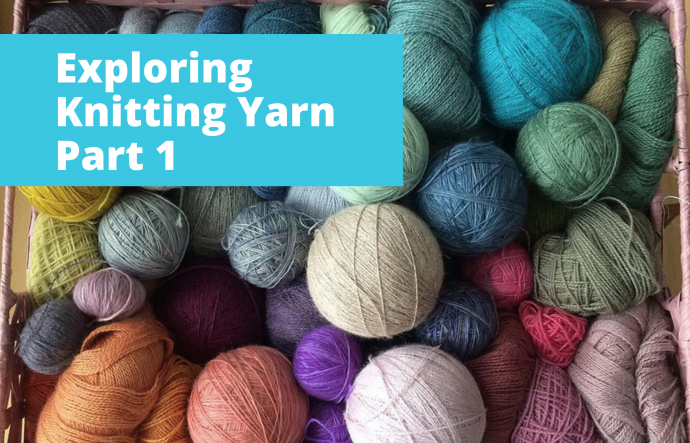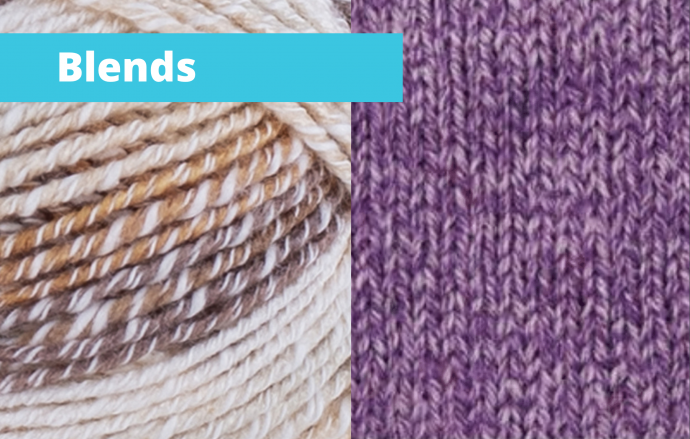It is important to note that using different yarn fibers with wield different results in your knitting project. If a pattern specifies what yarn to use, try to use the exact yarn or something similar in fiber content.
I hope this little guide has been helpful in finding out what materials to choose and how to use them.
If I forgot anything, please let me know down in the comments. I would love you to share any tips you have about the fibers you love as well. Have a great day!
Are you looking for the best yarn for knitting your various projects?

With the wonderful variety of yarns available today, the knitter or crocheter is often faced with a dilemma when it comes to purchasing. Luckily, there are some general guidelines when it comes to choosing types of yarn for your projects. For the most part, certain yarns are best for certain project types. I know it’s hard, as there are so many types of yarn whether they be from an animal or plant. The textures of each and how they knit up vary. Therefore, I would like to share my knowledge of all the different types of yarn and some recommendations of how to choose them properly. Hope it will be useful! Enjoy!
Acrylic is the go-to choice for many knitters and crocheters.

It’s inexpensive, comes in a huge variety of finishes and colors, and is widely available. Acrylic is not as breathable or absorbent as wool, but it's machine washable and tough, as you’ll know if you’ve ever tried to break a strand with your hands!
Pure acrylic yarn is often used for homewares, baby clothes and blankets, and rough-and-tumble children’s garments, and the fiber is also added as a mixer to many of the most popular yarns available. It’s perfect too for outside makes, like bunting, as it will withstand any weather and dry out quickly. If you are on a tight budget, it’s a great way of keeping the cost down, with acrylic yarns starting from around $1 per 100g ball.
Perfect for: Beginners Knitters attempting their first projects like scarves. 100% acrylic is the type of yarn for yarn braids. This yarn is ideal for multi-color projects.
Alpaca is a super warm fiber perfect for knitting sweaters.

Alpaca is natural wool that comes from the South-American Alpaca. Alpaca yarns have a softness that easily competes with mohair and cashmere and is well suited for garments that will rest directly against the skin. A dense fiber, alpaca yarns provide excellent stitch definition and work wonderfully for textured patterns. Although it is quite soft, almost silky, it doesn’t hold its shape as well as wool does. It’s usually a little more expensive and luxurious than regular wool. Alpaca fiber is water repellent, and it’s also difficult to make it catch fire!
Perfect for: shawls, scarves, and lightweight sweaters. If you are allergic to sheep's wool, wearing a sweater made from alpaca yarn won't bother your skin.
Wool yarn is elastic, insulating, flame resistant, and resists odors and bacteria.

Elasticity is important; it means that the clothing can stretch, but also bounce back, so that you don’t end up wearing a potato sack instead of a cardigan. Insulation is an obvious plus when you are knitting winter weather clothing and accessories. However, it is also breathable, which keeps you warm, but comfortable. There are 4 different types of wool yarn: Wool Type Fine, Wool Type Medium, Wool Type Long and Wool Type Double – coated. Types of fine wool yarn such as merino are wonderfully soft. Wool does have some negatives though! Unless it is labeled superwash, most wool yarn cannot be machine washed; and the lanolin in wool can also cause allergies in some people. Wool also tends to be more expensive in comparison to other yarn types.
Perfect for both winter and summer. It’s great for making scarves, sweaters, gloves, hats, socks and other clothes.
Cashmere is one of the softest and fluffiest wool and yarn types around.

It comes from the Cashmere Goats and several other types of goats. The word Cashmere comes from the old spelling of the old State of Kashmir in South Asia. Why is it so expensive I hear you ask? Well, cashmere goats shed their undercoat once a year. The undercoat is closer to the skin and must be separated from the outer hair. It comes from the animals mid-side and back, not their bellies. Unlike sheep who are shorn, the goats undercoat is combed and collected, which is labor intensive.
Perfect for jumpers, socks, gloves, etc.
Cotton is strong and breathable.

Not my favorite yarn to work with. While this is a strong yarn, it does not block well at all (it is a rather rigid yarn) and will highlight the irregularities in the stitches. However, it is light and breathable, so once you've gotten the hang of knitting, you can attempt to make summer garments.
Perfect for: summer knits, dishcloths, potholders, etc.
Silk is expensive, but strong, shiny and lustrous.

It’s not the warmest yarn so it is best for summer projects. It is also slippery to work with, so hold off for a while before tackling a project using silk yarn. Strong as steel in the tensile sense, silk is the strongest natural fiber known to humans.
Perfect for: summer items, as it has a lovely feel on the skin.
Blends are among the most popular yarns.

Want a summer yarn that feels light and breezy? Try cotton with lightweight acrylic. Love alpaca but it’s too hot? An alpaca/wool or cotton mix will be perfect! Blends also enable mills to create unusual yarns. Synthetic fibers can be much cheaper than animal or plant fibers, too. If you adore cashmere, silk or wool, keep your eyes peeled for blended yarns that feature some of your favorite fiber. It’ll be usually mixed with acrylic, viscose or nylon, and will often be cheaper!
In conclusion, there are so many types of yarns you can use. Next time I will tell you more about organic yarn, hemp and mohair, novelty, bamboo and linen.









I've been wanting to find some blended yarn but not sure what brand to look into for the best type and deal. Do you have any recommendations?
Do far I've only worked with 100% acrylic and 100% cotton. I find also that cotton does shoe the defects of crochet.😊